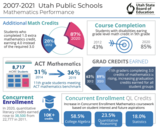
2007-2021 Utah Public Schools Mathematics Performance
- Subject:
- Mathematics
- Material Type:
- Reading
- Provider:
- Utah State Board of Education
- Provider Set:
- Utah Mathematics
- Date Added:
- 04/26/2022

2007-2021 Utah Public Schools Mathematics Performance
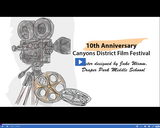
The Canyons School District is celebrating 10 years of the Canyons District Film Festival. Each year students from around the district make short films in different categories: Animation, Documentary, Short Film, Public Service Announcement and American Graduate, with one teacher's film being selected each year as well. This year, there is also a special Anniversary Documentary that tells us the history of the Canyons School District.

Stories about Navajo Four Seasons, Native American Cradleboards, Pia Toya Story, Parent Committee Special Projects, and Powwow Dancing.

Join this recorded webinar with information for any Google Admins.
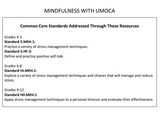
The Utah Museum of Contemporary Art has provided this lesson plan to accompany the three 2022 mindfulness videos. This lesson plan covers how students can respond to and further develop the concepts explored in the videos. The lesson plans covers stress management, positive self-talk, breathing and more.
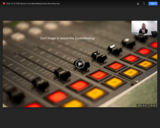
The PCBL Review Committee meets monthly to discuss resources, site visits, and materials connected to the PCBL Grant Program
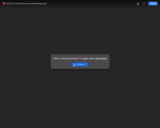
Zoom recording of our PCBL Review Committee Meeting for Februrary 2023
Topics covered include:
11:35 AM PCBL News & Events
11:45 AM Grant Application Information & Webinars
11:50 PM Questions for the Committee
1. PCBL Application on Website? or eMedia Hub? or both?
2. Request for Data regarding R277-419
12:10 PM Magellan Summit Review
12:30 PM Global Online Academy
12:45 PM Problems of Practice Breakout Rooms
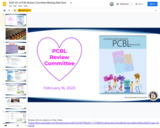
Here is the agenda, slides, and all the links discussed in our February 2023 PCBL Review Committee meeting.
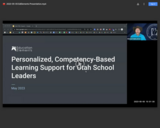
Drew Schantz, Associate Partner and Blog Author with EdElements leads the meeting and share the diagnostic “needs assessment” tool to help identify professional learning opportunities, consulting services, and other supports that might help their learning community move forward with personalized competency based learning.

This newsletter contains legislative updates related to library media education in the state of Utah.

Students can answer the quiz questions to see how their political beliefs match their political parties and candidates. The survey questions are balanced, and students can learn more about a topic or pick their on response if the ones listed don't match what they think.

Includes dates and information about elections. Includes information related to presidential primaries, voter registration, ballot request due dates, dates ballots must be postmarked by, candidate information packet, vote-by-mail request dates, general elections, dates to register to vote in general election, regular general election, and dates for statewide canvassing.
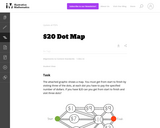
This problem helps students practice adding three numbers whose sum are 20 or less.

This lesson plan created by George Washington's Mount Vernon explores primary sources with 20 questions. There are printouts for historical places, prints, objects, and recipes.

This site has collected and currated 20 photos of Utah that were taken as part of the New Deal photography project. These photos can be used at any level and in a variety of ways in the classroom.
![20+ ways to use Gemini for Google Workspace in education [Shared]](https://emedia.uen.org/static/newdesign/images/materials/default-thumbnail-index.png)
This deck showcases how educators and students can chat with Gemini at gemini.google.com and use Gemini across Google Workspace apps.
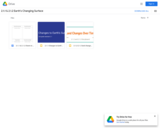
Google folder with Googles Slides and accompanying studnent journal files

This is a second-grade student science experience tied to SEEd standard 2.1.1. In this experience students use models to obtain information about the patterns in shapes of canyons.
These experiences were designed to support students in engaging in science investigations with siblings and/or parents at home and then report back about what was discovered. They were created in a way that is easily adaptable for both online and printed formats. They are formatted to help students wonder about and investigate the science phenomena happening in the world around them. These experiences do not describe how students should write up and return work to their teacher. It is up to each teacher to adapt them to best meet student needs. When individualized by the teacher, a student could be asked to engage in one or more of these experiences a week and report back. This format aligns closely to the vision and expectation of the SEEd standards.

This is a second-grade student science experience tied to SEEd standard 2.1.2. In this experience students construct explanations about what changes to EarthÕs surface occur quickly or slowly.
These experiences were designed to support students in engaging in science investigations with siblings and/or parents at home and then report back about what was discovered. They were created in a way that is easily adaptable for both online and printed formats. They are formatted to help students wonder about and investigate the science phenomena happening in the world around them. These experiences do not describe how students should write up and return work to their teacher. It is up to each teacher to adapt them to best meet student needs. When individualized by the teacher, a student could be asked to engage in one or more of these experiences a week and report back. This format aligns closely to the vision and expectation of the SEEd standards.

21st Century Learning Design (21CLD) for Educators is a collection of eight modules. The learning path provides educators with clear and practical ways to develop 21st skills using digital technologies with their learners. 21st Century Learning Design for Educators builds on the research methodology providing a collaborative, practice-based process to help educators transform how they design enriching learning activities for their learners. The complete series of eight courses consists of videos, reading materials, rubrics for each dimension, and anchor lessons. Educators can actively participate by coding anchor lessons and redesigning their learning activities according to the 21CLD rubrics